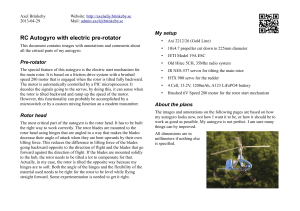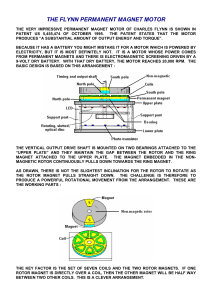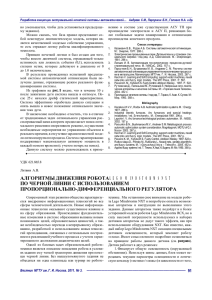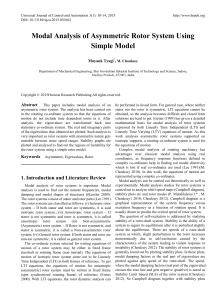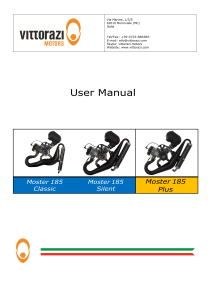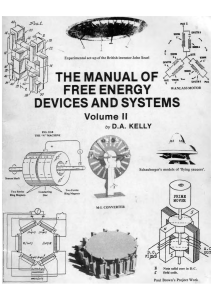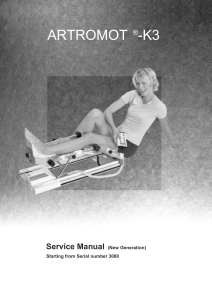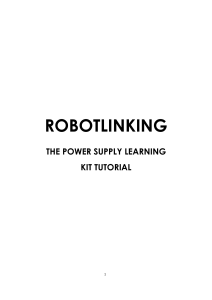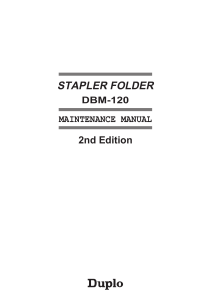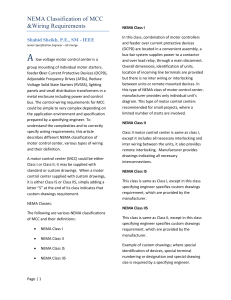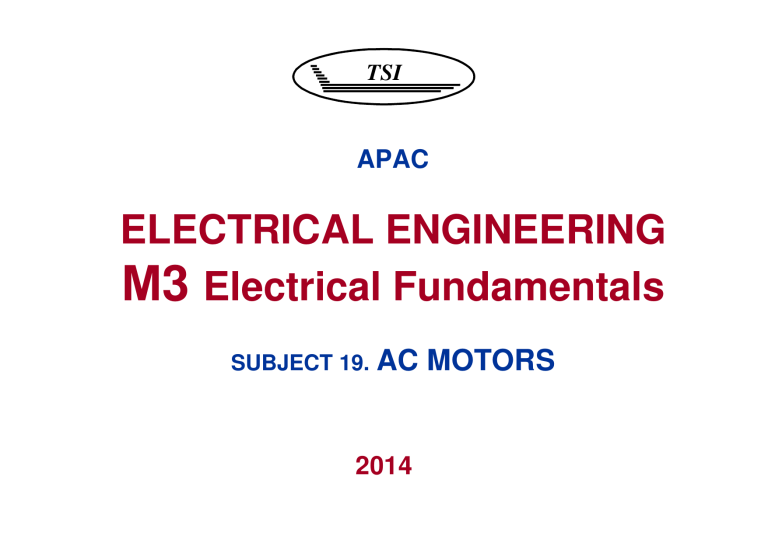
TSI APAC ELECTRICAL ENGINEERING М3 Electrical Fundamentals SUBJECT 19. AC MOTORS 2014 AC motors. Designation Used in automated electrical drives, that provide speed and position control of different compressors, pumps, fans, lifts, gyroscope devices and others. Main principals of magnetism and electromagnetic inductance, used in DC motors, relate to AC motors as well. AC motors do not need a commutater (collector) for rotor electrical supply, because AC changes its direction with magnetic flow direction. Three main types of AC electrical engines: • asynchronous motors • synchronous motors • universal motors 2 AC motor principle Brushes Axis Rotation momentum Contact rings Force When a loop is connected to the source of alternating EMF with the help of two contact rings, electrical current flows through it, creating a magnetic field around it. This field interacts with the excitation magnetic field (stator) and creates a rotation momentum. 3 AC motor principle Excitation current (stator) Motion is created by the rotating magnetic field Motion direction of the conductor depends on the direction of this current relatively to the magnetic field and can be defined by the “lefthand rule”. 4 Asynchronous (inductance) motor operation principle For Contact ce rings Rotor coil Asynchronous is an electrical motor, the armature coil frequency of which differs from rotation frequency of the rotor shaft. Shaft Brushes Starting rheostats The principal of operation of the asynchronous motor is based on interaction between the rotating stator magnetic field with rotor coil currents, that appear as a result of coil EMF inductance. Asynchronous motor coil are SHORT CIRCUITED 5 Asynchronous motor. Construction If a fixed conductor crosses by a rotating stator magnetic field, then voltage is induced. Asynchronous motor in the moment of the start acts like a fixed TRANSFORMER. Induced voltage is called electromotive force (EMF). Earmature = 4,44 ⋅ kA ⋅ wA ⋅ f1 ⋅ ΦE Points of mounting Then in a short circuited rotor coil AC flows and creates its rotating magnetic field. Armature Enclosure I armature = E armature / Z A , Rotor shaft where Z A = R 2A + X 2A Stator coil This field interacts with the stator magnetic field and creates a rotation momentum. МЭ = СМА ⋅ Φ E ⋅ IA ⋅ Cos(ϕ A ) 6 Asynchronous motor. Armature construction Bearings Stator Rotor coil Rings Fan Rotor core Rotor Contact rings Bearings Phase short-circuited rotor Starting rheostats Starting rheostats output, while starting, R=мах, and then with their help momentum and speed can be regulated up to short circuit mode (R=0) (used for high-power systems) 7 Rotor construction “squirrel cage” а) Copper “squirrel cage”, poured with aluminum (or hollow) for low-power motors Stator Short-circuited rotor b) Aluminum plates in laminated steel slots Rotor construction “squirrel cage” has its main advantage – absences of electrical sliding contact with the rotor (this provides simplicity, reliability, low cost) 8 Asynchronous motor. Sliding Main parameter (asynchronicity measure) of the asynchronous motor is a measure, called sliding S. Collector brushes Щетки токосъемников Rotor Ротор Контактные Contactкольца rings Статор Stator Sliding: Sliding shows, how the rotor rotation frequency n2 lags behind the rotating excitation magnetic field (stator) n1. Where the synchronous frequency is: S= n1 − n2 n1 n1 = (%) 60 ⋅ f p The motor mode is only available if S > 0. 9 Asynchronous motor characteristics Motor mode Режим двигателя Breaking mode by concurrent Режим торможения connection противовкючением Mmax -Sk -1 n1 nK R1<R2 R2 S 0 Generator mode Режим генератора n Speed М Sk 1 - Mmax Mechanical characteristic 0 М МП Момент Мmax Momentum Mechanical (speed) characteristic fSYNCHR = n⋅p 60 [ Hz ] n = n 1 ⋅ (1 − S ) S K ≈ 0 ,1 ÷ 0 ,15 S 0 ≈ 0 ,005 ÷ 0 ,01 S H ≈ 0 ,04 ÷ 0 ,05 Work characteristic Power when 10 Asynchronous motor start Phase rotor asynchronous motor start Stator Starting rheostat, when starting, are set to the maximum position, and then after the start – into the short circuit mode (R=0) Speed Скорость Rings Rotor Starting rheostats Short-circuited rotor asynchronous motor start Stator Short-circuited rotor asynchronous motor start methods exist: 1. Direct switching (relative to the available power in the mains) 2. Mains switching with a preemptive decreasing of voltage on the stator coils: • • n2 = n1 ⋅ (1 − S) n2 = Momentum 60 ⋅ f1 ⋅ (1 − S) p Using a reactor (capacitor block) Using a autotransformer Asynchronous motor control: Conducted by changing the value of voltage f, the number of pole pairs p, parameters, that affect sliding S 11 Three-phase asynchronous motor operation in a singlephase mains Stator Stator Short-circuited rotor Short-circuited rotor Stator Three-phase asynchronous motor can work in a single-phase mains, if its coils are connected with a phase shifting capacitor to 900 according to the schematics (i.e. convert it to a single-phase motor) Short-circuited rotor 12 Single-phase asynchronous motor A single-phase motor has a main coil, and a support coil. The starting capacitor is switched on to create a starting rotation momentum. L1 L2(N) After the motor start, the capacitor is switched off using the time relay or centrifugal contact. Контакт Relay contact реле The capacity of phase-shifting capacitor С is picked in a way, to make the currents in the main and support coils differ by a phase of 900. С w z Support Вспомогательная обмотка coil u v Реверс Reverse М Главная Main coil обмотка To create a reverse in a single-phase asynchronous motor, the starting capacitor must be connected between different outputs (u and v terminals switched) 13 Asynchronous single-phase motor with a split phase (capacitor start) Mains The formation of a rotating field: using a capacitor, occurs in a motor with a capacitor start. This motor with a split phase, that the support coil Б with a capacitor is connected only during the start time. Capacitors creates a phase-shift of 900 between currents of coils А and Б, axis of which are shifted in space. The biggest rotating momentum is gained, when the phase-shift is equal to 90°, but its’ amplitudes are chosen so that the rotating field becomes circular. When starting the capacitor asynchronous motor, both of the capacitors must be switched on, and after its acceleration, one of its capacitors is switched off, because during nominal rotation frequency, a substantially lower capacitance is required, than during the start. Used in low-power electrical gears. 14 Asynchronous motor with shielded poles in a singlephase mains Short-circuited copper ring Shielded poles are used to start the motors in lowreserve power systems. Shielded pole “Squirrel cage” rotor Short-circuited copper rings are placed around the shielded poles, and play the role of transformers, forming a support coil, used during engine start. Two magnetic fluxes, created by two currents, shifted by phase one relative to another, create a common rotating field, which allows the rotor to rotate. A single-phase motor, which works this way, functions as a motor with a “split phase”. 15 AC Synchronous motor The naming of the synchronous motor is connected with the fact that in static mode its rotor rotates with the same speed, as the magnetic field, i.e. synchronously. As opposed to the asynchronous motor the rotation frequency of the synchronous motor is constant during different loads. Synchronous motors are used as gears for constant speed machines (pumps, compressors, fans). There are no constructional differences between the synchronous motor and generator: • A coil supplied by three-phase current and forming a rotating magnetic field is placed on the stator. • The motor rotor is comprised from the core with an excitation coil or a permanent magnet 16 Reactive synchronous motor. A synchronous motor, that has no excitation coil on its rotor, is called a reactive synchronous motor. A rotor of this motor is made from ferromagnetic materials and must have pronounced poles. Stator The stator rotating magnetic field magnetizes the rotor. Rotor This kind of rotor has different magnetic resistances longitudinally and transversally to the pole axis. n1 = n2 n1 = 60 ⋅ f p Magnet field deformation causes, because of the resilient characteristics of the force lines, reactive momentum, that rotates the rotor synchronously with the stator field. n1 – rotating magnetic field frequency n2 – rotor rotation synchronous frequency 17 Synchronous AC motor The rotors of the synchronous motors are made as salient pole (with pronounced poles) and non-salient Communica tion box Poles Three-phase synchronous motor (1 pole pair) Brushes Core Excitation coils Rotor shaft Contact rings Salient pole rotor (used for quiet machines) Synchronous motor (2 pole pairs) 18 Synchronous motor with a non-salient pole rotor Ferromagnetic cylinder Excitation coil Rotors of synchronous motors are made non-salient poled and are used for highspeed machines. Armature coils Brushes Rotor shaft Non-salient pole rotor Rotor shaft Core with slots Contact rings 19 Synchronous motor start Synchronous motors do not have a start momentum, because the electromagnetic rotation momentum, that affects a fixed rotor, changes its direction two times in one period of AC Т. Because of inertia the rotor does not budge in time and и can’t reach the required rotation value, that is why a special start is required. 1. Acceleration motor start. A special starting DC electric motor starts the synchronous motor up to the synchronous speed and then turns off. Short-circuited rotor rods “squirrel cage” Stator core Excitation coils 2. Asynchronous start. Is done by an additional short-circuited rotor coil. In the synchronous mode it does not work. Permanent magnet Rotor core 3. Excitation current frequency increase start. Used, if there is a possibility to smoothly regulate the frequency of the source voltage from 0 to nominal. 20 Synchronous motor working characteristics • cosφ can reach 1 while regulating the rotor excitation, М2 lineary dependent from shaft power Р2, because n2 = const, i.e. does not depend on Р2. While overexcited (IE > IEN) for the external mains, the motor presents a capacitive load (φ<0). • Efficiency relatively high with a permanent magnet, because there are no losses on the rotor excitation. • The consumed current, while the Р2 increases, changes insignificantly. 21 Synchronous motor advantages and disadvantages Advantages: • The ability to work, whe cosφ = 1, what improves the cosφ mains, as well as to a decrease of the motor size, because its current is lower than the current of the asynchronous motor of the same power. • Smaller sensitivity to voltage fluctuations, because the rotation momentum is proportional to first degree voltage, and not the square voltage, as the asynchronous motor has. • Frequency constancy of the rotation independently from mechanical load on the shaft. Disadvantages: • More complex construction, than a short-circuited asynchronous motor: a synchronous motor must have an exciter or another device for supplying the excitation coil with DC. • Complex start. • Difficulties with regulating rotation frequency, that may be used only while changing the supply voltage frequency. 22 DC terminals AC terminals Universal (collector) synchronous motor A motor, that is able to work from both AC and DC sources EC1 Unlike DC motors, universal motors consist of a laminated stator and a rotor core, that decreases eddy currents while supplied by AC. The motor operation on AC is possible only then, when currents in the stator coil and in the armature coil change synchronously, when supplying AC to the universal motor. UM There are two excitation coils on the motor poles: the first one – to operate from the AC mains, the other is connected in serial with the first when the motor operates from DC. EC2 Universal motors are used in vacuum cleaners, in hand operated drilling tools and other devices, that require small amounts of power. 23
